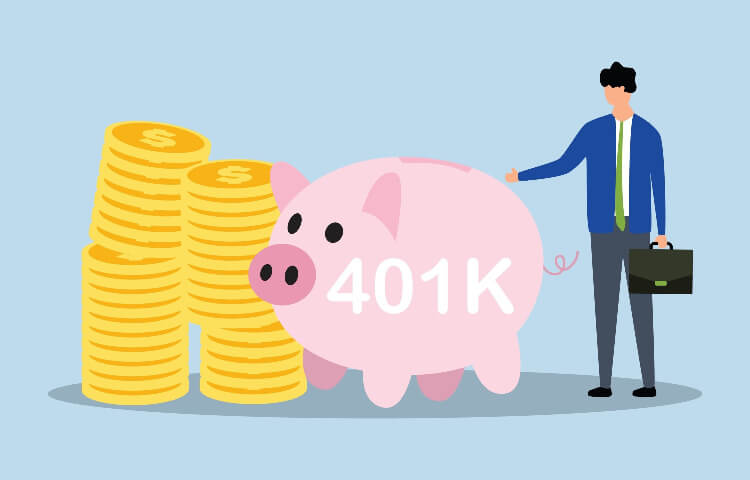As a successful self-employed professional, you’ve mastered your craft. Whether you’re an IT consultant, a marketing guru, or a freelance designer, your expertise commands a high income. But with that success comes a growing and frustrating problem: a significant annual tax bill that eats directly into your hard-earned revenue. You’ve likely been diligent, contributing to a SEP IRA, which is a great starting point. But as your income grows, you’re hitting a ceiling, feeling that your retirement plan isn’t working as hard as you are.
If you’re looking for a way to dramatically reduce your taxable income while supercharging your retirement savings, it’s time to look beyond the SEP IRA. For high-earning solopreneurs, the Solo 401(k) is not just an alternative; it’s a strategic upgrade. This plan is specifically designed for self-employed individuals and their spouses, offering unparalleled contribution power, tax flexibility, and features that a SEP IRA simply can’t match.
Key Takeaways
- Solo 401(k)s allow higher contributions at lower income levels than SEP IRAs, thanks to both employee and employer contributions.
- Roth contributions and loan access make the Solo 401(k) more flexible and powerful than a SEP IRA.
- Slightly more admin, but full-service providers handle the details, making the Solo 401(k) easy to manage.
The Contribution Power Gap: Why the Solo 401(k) Outperforms the SEP IRA
The fundamental advantage of the Solo 401(k) lies in its unique contribution structure. As the business owner, you can contribute as both the “employee” and the “employer.” A SEP IRA only allows for employer contributions. This dual-role contribution is what creates a massive gap in how much you can save each year, especially at higher income levels.

Let’s break it down with 2025 IRS limits:
- As the employee, you can contribute up to 100% of your compensation, maxing out at $23,500 (or $31,000 if you are age 50 or older).
- As the employer, you can contribute an additional 25% of your compensation.
The total combined contributions cannot exceed $70,000 for 2025 (or $77,500 if age 50 or older). A SEP IRA’s limit is also $70,000, but because it only allows for the 25% employer contribution, you need a much higher income to reach that maximum. Note: Starting in 2025, there is an extra bump for those between the ages of 60 and 63 that brings the total catch-up amount to $11,250 for a total limit of $81,250.
Consider a 45-year-old consultant with $150,000 in net adjusted self-employment income:
- With a SEP IRA: The maximum contribution is 25% of compensation, totaling $37,500.
- With a Solo 401(k): He or she can contribute $23,500 as the employee PLUS $37,500 as the employer, for a total of $61,000.
That’s an extra $23,500 in tax-deferred savings in a single year, directly lowering your adjusted gross income and your tax bill.
Solo 401(k) vs. SEP IRA: 2025 Head-to-Head Comparison
For a clear, at-a-glance view, this table breaks down the key differences that matter most to a high-earning business owner.
| Feature | Solo 401(k) | SEP IRA |
|---|---|---|
| Eligibility | Self-employed individuals with no full-time employees (spouse can participate). | Any size business, including self-employed individuals. |
| Contribution Structure | Employee + Employer contributions. | Employer-only contributions. |
| 2025 Max Contribution (Under 50) | $70,000 (combined employee/employer). | $70,000 (or 25% of compensation, whichever is less). |
| Catch-Up Contribution (Age 50+) | Yes, an additional $7,500 as an employee contribution. | No. |
| Roth Contribution Option | Yes, for employee contributions, allowing for tax-free growth and withdrawals. | Generally no. The SECURE 2.0 Act introduced a Roth option for SEPs, but it is not yet widely available with most providers. |
| Participant Loan Availability | Yes, borrow up to $50,000 or 50% of the account value. | No, loans are not permitted from any IRA. |
| Administrative Complexity | Slightly more complex. Requires annual Form 5500-EZ filing once assets exceed $250,000. | Very simple, generally no annual filing requirements. |
Unlocking Tax-Free Growth with the Roth Solo 401(k)
One of the most forward-thinking features of the Solo 401(k), and a clear differentiator from the SEP IRA, is the ability to make Roth contributions. This gives high-earning solopreneurs access to a powerful long-term strategy: tax-free growth and tax-free withdrawals in retirement.
Here’s how it works: when you contribute to the Roth side of a Solo 401(k), you’re using after-tax dollars for your employee portion (up to $23,500 in 2025, or $31,000 if you’re age 50+). Unlike traditional pretax contributions, you don’t get a deduction today, but the payoff comes later. All the investment growth within the Roth account, plus qualified withdrawals in retirement, are 100% tax-free.
This is a huge advantage for professionals who expect to remain in a high tax bracket for the long haul. Paying a known tax rate today may be smarter than gambling on a potentially higher one in the future. By locking in today’s rates, you’re essentially creating a bucket of tax-free income that can be strategically drawn from in retirement—giving you far more control over your overall tax liability.
Compare that to a SEP IRA: while the SECURE Act 2.0 technically introduced Roth SEP IRAs, most custodians haven’t adopted the Roth option, and the rules around Roth SEP contributions remain murky and impractical for most investors. In contrast, Roth contributions in a Solo 401(k) are well-established, accessible, and easy to manage—especially with a modern provider.
For savvy investors, the Roth Solo 401(k) offers a unique combination of tax diversification, growth potential, and withdrawal flexibility that’s hard to beat. Whether you’re aiming to minimize Required Minimum Distributions (RMDs) down the line, leave a tax-free legacy, or simply gain more control over your retirement income, the Roth Solo 401(k) gives you options that a SEP IRA simply can’t match.
Book a free call with a self-directed retirement specialist
- Review your self-directed retirement options
- Learn about investing in alternative assets
- Get all of your questions answered
A Strategic Safety Net: The Power of a 401(k) Loan
One of the most underappreciated yet powerful features of the Solo 401(k) is its built-in loan provision, a benefit not available with SEP IRAs, traditional IRAs, or even most employer-sponsored retirement plans. For self-employed individuals and small business owners, this can be a game-changer.
With a Solo 401(k), you’re allowed to borrow up to $50,000 or 50% of your account balance (whichever is less), and you can use the funds for virtually any reason. Whether it’s covering a short-term cash crunch, seizing a time-sensitive business opportunity, putting money toward a home down payment, or managing an unexpected medical bill, the flexibility is unmatched.
Even better, you’re not borrowing from a bank or a third-party lender—you’re borrowing from yourself. And when you repay the loan, including a modest interest rate (typically the Prime Rate + 1–2%), the payments go back into your own Solo 401(k) account, not to a creditor. That means you’re effectively paying yourself interest and reinvesting in your future.
Compare this to a SEP IRA: there is no loan option whatsoever. Any early distribution before age 59 ½ generally comes with a 10% IRS penalty plus ordinary income tax—a serious hit to your retirement savings. That lack of flexibility can leave SEP IRA holders without options in a financial pinch.
The Solo 401(k) loan provision acts as a built-in safety net—giving you peace of mind that your retirement plan can adapt when life throws you a curveball. It’s this kind of strategic control and liquidity that makes the Solo 401(k) an especially attractive choice for high-income, self-employed professionals.
Navigating Complexity: You Don’t Have to Go It Alone

The immense power of the Solo 401(k) does come with slightly more administrative complexity than a SEP IRA. The most notable requirement is filing Form 5500-EZ annually once your plan’s assets exceed $250,000. This is a legitimate concern for a busy professional whose focus should be on their business, not on navigating IRS compliance.
This is precisely where choosing the right partner is critical. A full-service Solo 401(k) provider like IRA Financial doesn’t just set up your account; we act as your dedicated partner to ensure compliance and ease of use. We help you establish the plan, provide clear guidance on calculating your maximum contributions, and handle the annual Form 5500 filing on your behalf. We empower you to leverage this incredible tool with confidence, knowing the administrative details are being managed by experts.
The Verdict: Graduate from the SEP to the Solo 401(k)
The SEP IRA served you well when you were starting out. It was easy, low maintenance, and a step in the right direction. But you’re not just starting out anymore—you’ve built something. Your income is higher, your goals are more ambitious, and your expectations for your retirement plan should be too.
The Solo 401(k) isn’t just a different plan. It’s a smarter, more strategic tool for high earners who want to optimize their tax strategy, maximize retirement contributions, and retain control over their financial future. With higher contribution limits, Roth flexibility, and built-in loan access, the Solo 401(k) offers advantages that a SEP IRA simply can’t compete with. Yes, it comes with a bit more administrative responsibility, but with the right provider like IRA Financial, that complexity is managed for you, allowing you to focus on growing your business and wealth without missing a beat.
If your income has outgrown your SEP IRA, it’s time your retirement plan caught up. The Solo 401(k) gives you the tax advantages, investment flexibility, and liquidity you need to turn your high earnings into long-term financial freedom.
Your SEP IRA served you well, but your income and goals have outgrown it. A Solo 401(k) gives you higher contribution limits, Roth flexibility, and loan access—all with the guidance of a full-service provider.
Ready to level up? Your SEP IRA served you well, but your income and goals have outgrown it. A Solo 401(k) gives you higher contribution limits, Roth flexibility, and loan access—all with the guidance of a full-service provider. Schedule a call with our experts or sign up for a new account and unlock the full power of the Solo 401(k), because your future deserves more than the basics.
Frequently Asked Questions (FAQ)
Can I have a Solo 401(k) if I also have a 401(k) at a full-time W-2 job?
Yes. However, your total “employee” contributions across both plans cannot exceed the annual IRS limit ($23,500 for 2025, plus catch-up if applicable). You can still make the full “employer” contribution to your Solo 401(k) based on your self-employment income.
What is the deadline to open and fund a Solo 401(k) for the 2025 tax year?
To make employee contributions for 2025, you must establish the Solo 401(k) plan by December 31, 2025. The employer contribution can be made up until your business’s tax filing deadline (including extensions) for the 2025 tax year.
How are contributions calculated if my business is an S-Corp?
If you operate as an S-Corporation, your contributions are based on the W-2 salary you pay yourself. The employee contribution comes from your salary, and the employer contribution is up to 25% of that same salary. This differs from a sole proprietorship, where contributions are based on your net adjusted self-employment income.
What happens to my Solo 401(k) if I hire a full-time employee?
Once you hire a full-time employee (other than your spouse), the Solo 401(k) is no longer a compliant plan. You would need to either terminate the plan and roll the assets into an IRA or another qualified plan, or convert it to a standard 401(k) plan that covers your new employee(s).
What is Form 5500-EZ and do I have to file it?
Form 5500-EZ is an annual information return filed with the IRS for one-participant retirement plans. You are only required to file it if the total assets in your Solo 401(k) are $250,000 or more on the last day of the plan year (December 31). If your assets are below this threshold, no filing is necessary.



